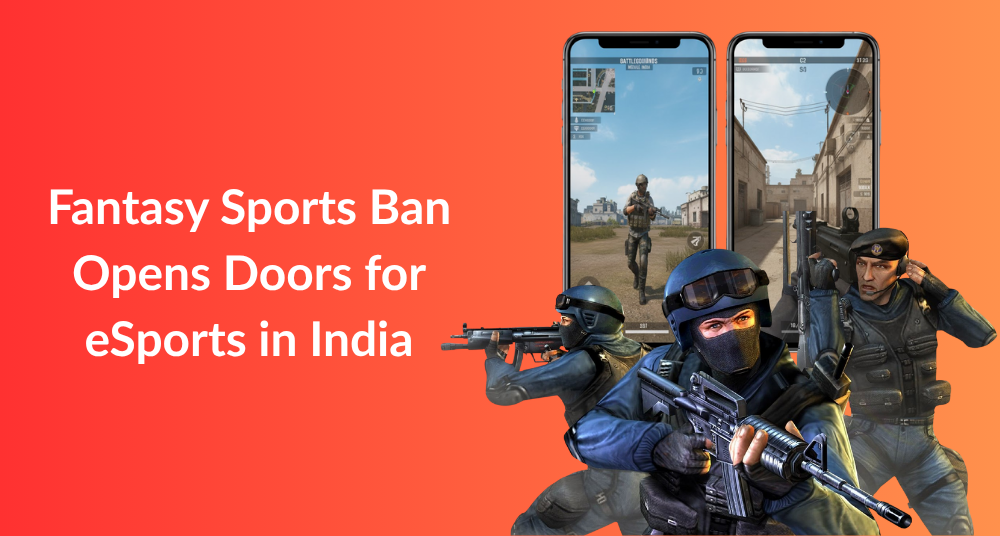Introduction
Fantasy sports entered India in the latter half of the 2010s, riding the wave of mobile penetration, sports fandom (especially cricket) and the rise of “earn-while-playing” models. The sector ballooned to enormous scale: as of December 2023, it was reportedly valued around ₹45,000 crore (US $5 billion) with an active user base of over 180 million. However, on 21 August 2025, the Promotion and Regulation of Online Gaming Bill, 2025 was passed by the Indian Parliament, effectively banning all online games played for money or stakes — including fantasy sports — on the grounds that they constitute “online gambling”.
While this has sent shock-waves through the fantasy-gaming ecosystem, it also opens an opportunity: the government explicitly signalled its intent to support “esports” and casual/social gaming. For companies, players and the industry at large this represents a pivot. This blog explores how fantasy sports were impacted, what the ban implies, and how the e-sports sector is positioned to become India’s next big thing.
What Happened: Fantasy Sports & the Ban
The rapid rise of fantasy sports
Fantasy sports platforms (e.g., cricket-based contests) found rapid adoption in India: fans could build virtual teams, pay an entry fee, and earn real-cash winnings based on real match outcomes. Growth was driven by celebrity endorsements, heavy marketing, sponsorships (for example via major leagues), and the convergence of sports-fans + mobile users.
By FY2024, major platforms like Dream11 had generated revenue in thousands of crores, with the real-money contest model forming the bulk of their earnings.
The regulatory turning point
Despite earlier Supreme-Court rulings classifying fantasy sports as “games of skill”, the new 2025 Bill changed the regulatory landscape:
- It categorically bans any online game involving money stakes or winnings, whether skill-based or chance-based.
- It prohibits offering, facilitating or promoting such games; restricts financial institutions from processing related transactions.
- Consequences include penalties (jail terms up to 3 years, fines up to ₹1 crore) for operators, promoters and advertisers.
- Immediately following the bill’s passage: major fantasy platforms suspended real-money contests and began transitioning to “free-to-play” models. Impact and industry shock
The fallout has been swift and broad:
- Platforms built on paid-entry, cash-winnings models face existential threat.
- Sponsorships and brand deals are impacted (sports leagues, celebrity endorsements) because the fantasy model powered much of this ecosystem.
- Thousands of jobs, startup valuations, investor commitments — all face uncertainty.
- In short: a major segment of India’s gaming ecosystem has suddenly been disallowed, compelling stakeholders to pivot or perish.
The Shift in Focus: Why eSports Now?
While the fantasy-gaming model is under regulatory fire, the government has pointed toward e-sports as a growth pathway: mentions in the Bill and in public statements highlight that e-sports, social games and purely competitive gaming (without monetary stakes) are still permissible.
What is eSports?
In simple terms, eSports are organised competitive video-games played by professionals or serious amateurs, often in teams, with viewership, prize-money, tournaments and spectatorship. Examples include titles like Counter‑Strike 2, Valorant, Free Fire and many mobile-based games.
Unlike fantasy sports (which involve entry fees + winnings contingent on real-world sports), e-sports are about direct gameplay, skill, tournaments and spectatorship.
India’s eSports growth story
India’s e-sports industry was already showing promising signs:
- An EY report estimated India’s eSports market could quadruple in size by 2025, reaching revenues of over ₹10,000 crore.
- Another source forecast the prize-pool in India growing at ~66% CAGR, with number of players expanding rapidly.
- As mobile is the dominant gaming platform in India, over 90% of e-sports players in India reportedly participate via smartphone.
Why eSports fits India’s landscape
Several structural tailwinds support the e-sports rise in India:
- Mobile dominance: High smartphone penetration + affordable internet means mobile e-sports can scale.
- Youth demographic: India has a large young population with growing interest in gaming as entertainment, competition and even career path.
- Infrastructure improvements: Better broadband, better devices, more affordable gaming gear over time.
- Viewership & monetisation potential: Sponsorships, tournament prize-money, in-game purchases, streaming, fandom.
- Regulatory clarity: The new bill’s explicit division (ban on “money-games” but support for e-sports) gives a clearer regulatory path for competitive gaming.
Thus, as fantasy sports falter under regulatory shadow, e-sports appear positioned as the next frontier.
The Scope & Opportunities for eSports in India
Competitive ecosystem & professionalisation
With more structured tournaments, leagues and platforms, Indian gamers can treat e-sports as a professional career — not just casual play. Earnings may come from prize-money, sponsorships, streaming revenue, brand endorsements and in-game monetisation.
Teams are forming, organisations are investing, and international competition beckons. Over time, India could produce world-class e-sports athletes, teams and brands.
Monetisation & business models
Even without the “real-money entry fee + winnings” model of fantasy sports, e-sports offers multiple revenue streams:
- Ticketing / live-event revenue for major tournaments
- Sponsorships & branding deals
- Streaming platforms, content creation, fandom
- Merchandising, licensing, in-game purchases
- Advertising, media rights for major events
Given the projected revenue jump (to ₹10,000 crore+ in India) the business model is viable.
Talent development and training ecosystems
India needs infrastructure: training centres, gaming studios, coaches, analytics, performance improvement tools. As this ecosystem builds up, the country can nurture local talent, regional tournaments, feeder leagues, and link to global e-sports circuits.
Regional & mobile-first advantage
Because India is mobile-first, games optimised for mobile platforms — such as Free Fire, Battlegrounds Mobile, mobile versions of global titles — can lead penetration. Given cost-barriers for high-end PCs/consoles, mobile e-sports offer a more inclusive path.
Moreover, regional language support, localization and grassroots activation can help reach semi-urban and rural youth.
New entrants and game development ecosystem
Beyond just playing, India can become a hub for game development, especially for mobile/competitive titles, E-sports infrastructure, commentary, event management etc. This creates ecosystem jobs beyond players: content creators, coaches, analysts, event managers, equipment vendors.
Educational & career pathways
Universities and institutes are increasingly recognising e-sports as a career option: scholarships, varsity teams, campus leagues. The shift in perception — from “just gaming” to “competitive sport” — can unlock new possibilities.
Media, streaming & content creation
Live streaming of tournaments, influencer-led gaming content, highlight reels, commentary, behind-the-scenes — all build audience and engagement. With the younger generation consuming digital content heavily, e-sports is well-poised.
Challenges & Considerations
While the scope is vast, some challenges remain:
- Infrastructure gap: In some parts of India, latency, internet access, quality hardware are still limiting.
- Monetisation clarity: Though prize-money and sponsorships exist, building sustainable revenue at scale takes time.
- Regulatory ambiguity: While e-sports are still allowed, clarity on how tournaments, winnings, taxation, and cross-border participation will be regulated is needed.
- Perception & legitimacy: Gaming as a career still carries stigma among some; building legitimacy, athlete welfare, anti-cheating frameworks matter.
- Talent retention: Players may still migrate abroad or shift to other entertainment segments unless the domestic ecosystem supports them.
- Game ecosystem diversity: India must avoid being overly dependent on one game/platform; building multiple titles and diversifying helps long-term stability.
What This Shift Means for Stakeholders
For Gaming Companies & Startups
- Fantasy-platform operators: Must pivot quickly — from real-money contests to free-to-play, or refocus on e-sports, content & streaming.
- e-sports platform builders: Opportunity to scale, innovate — build tournaments, leagues, content ecosystems.
- Game‐developers: Focus on competitive, mobile-optimised titles, localised content, and cross-platform integration.
For Players & Gamers
- The ban removes the real-money fantasy model, but offers a clearer competitive path via e-sports: training, tournaments, viewership, prize-money.
- Gamers may need to shift mindset: from casual contest entry to serious practice, team play, streaming, brand building.
- Opportunities in content creation (streaming, YouTube/Twitch), coaching, event participation open up.
For Brands & Advertisers
- With fantasy sports sponsorships diminishing, brands will increasingly engage with e-sports: tournament sponsorships, team partnerships, influencer collaborations.
- Viewing streaming and Indian e-sports viewership will become more important.
- Brands focusing on younger, digital-native audiences will find e-sports appealing.
For Government & Regulators
- The regulatory clarity (ban on real-money games, support for e-sports) offers a new industry growth pillar.
- Potential economic impact: jobs, startups, exports of e-sports content, foreign investment.
- Need for policy frameworks: athlete rights, international competition rules, data protection, taxation, anti-doping/cheating protocols.
Looking Ahead: What to Expect
- Rapid growth of domestic tournaments: National leagues, collegiate e-sports, regional qualifiers, mobile-first events.
- Greater visibility and media rights: As viewership grows (estimates suggest India’s e-sports audience could reach 85 million+ by 2025) tournaments will attract media deals.
- More investment and ecosystem building: Investors previously in fantasy-sports may redirect to e-sports platforms, creators, infrastructure.
- Global integration: Indian teams will increasingly compete in Asia/Americas; international titles may localise to India.
- New roles beyond players: Coaching, shoutcasting, analytics, event operations, content production — helping generate broader employment.
- Educative & formal structures: Esports academies, institutes offering degrees/certificates in e-sports management, team operations, streaming, etc.
- Monetisation innovation: Brands plus direct-to-fan models (NFTs, fan engagement, in-game purchases), subscription-based competitive leagues.
- Sociocultural acceptance: As e-sports becomes mainstream, it becomes socially acceptable as a career path.
Conclusion
The recent ban on real-money fantasy sports in India marks a dramatic turning point. What once seemed unstoppable — fantasy-sporting apps with millions of users and billions in valuations — has now been disrupted overnight. At the same time, the regulatory move signals clear intent: while the “pay to win” model is no longer acceptable, competitive digital gaming — namely e-sports — is very much welcomed.
For India, this presents a unique inflection point.
With its demographic advantage, mobile-first universe, growing digital ecosystem and global gaming trends, the country is well-placed to capitalise on the e-sports surge. While there are challenges ahead — infrastructure, monetisation, perception — the opportunities are real and sizeable.
For players, companies, and brands, the message is clear: adapt to the new paradigm, focus on competitive gaming, build content, community and professional pathways — and the era of Indian e-sports may just be beginning.
Related Blog: Most Popular eSports Games






What do you think?
It is nice to know your opinion. Leave a comment.